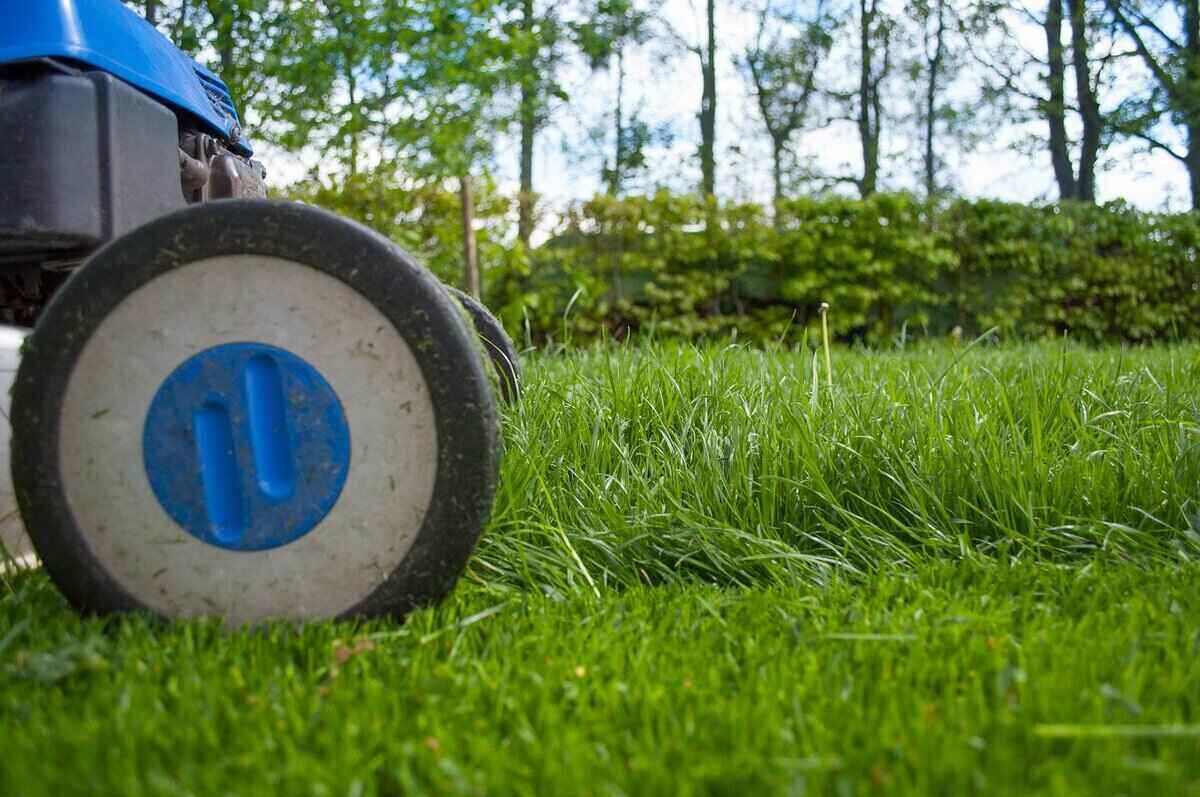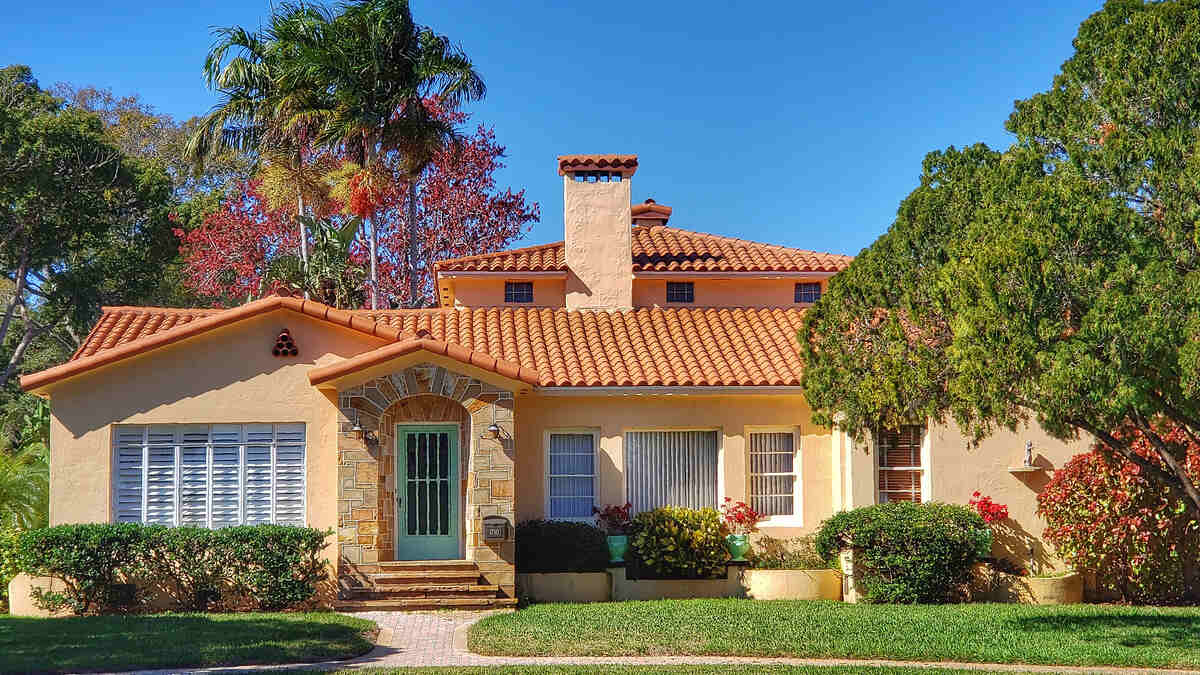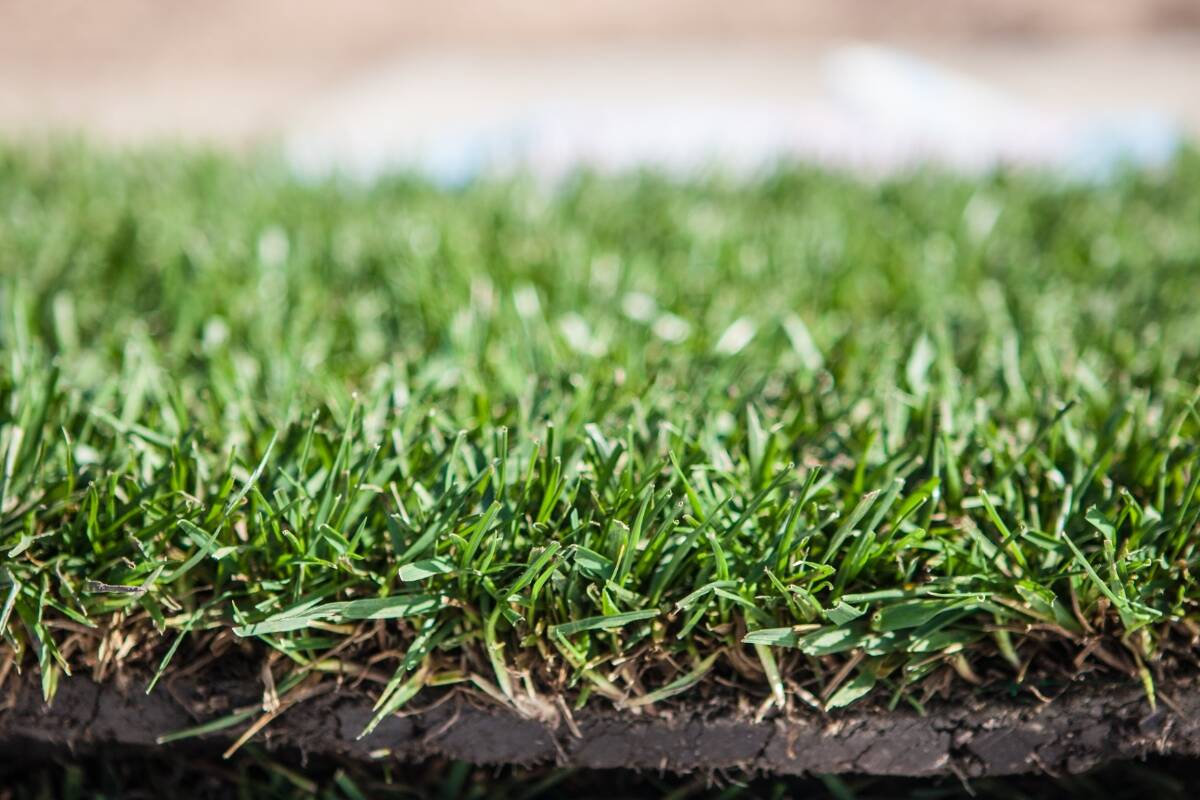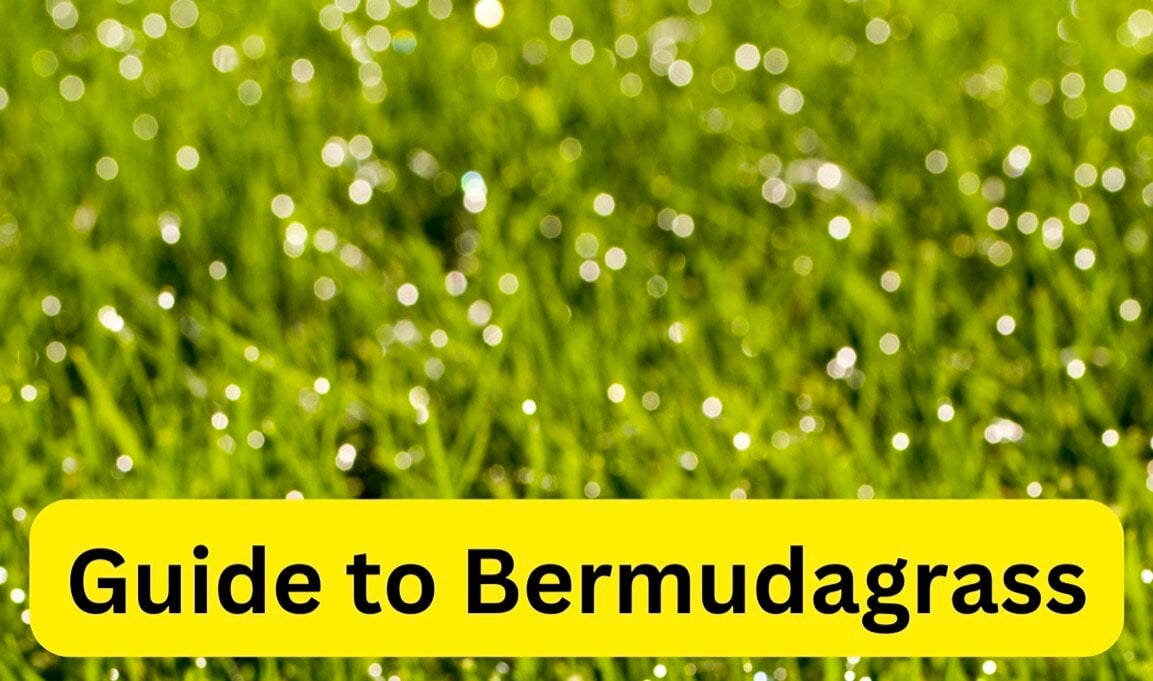
Bermudagrass is a high-quality turf with excellent drought, salt, and wear resistance that is common across the Southeast and South. The challenge or downside with bermudagrass is that it is a high-maintenance grass.
Thinking about getting bermudagrass for your lawn? This guide covers the characteristics of bermudagrass, care and watering of this turf, types of bermudagrass, and more.
First, let’s get this out of the way. Bermudagrass is not from Bermuda. This hardy turf most likely came from Africa, but more on that later.
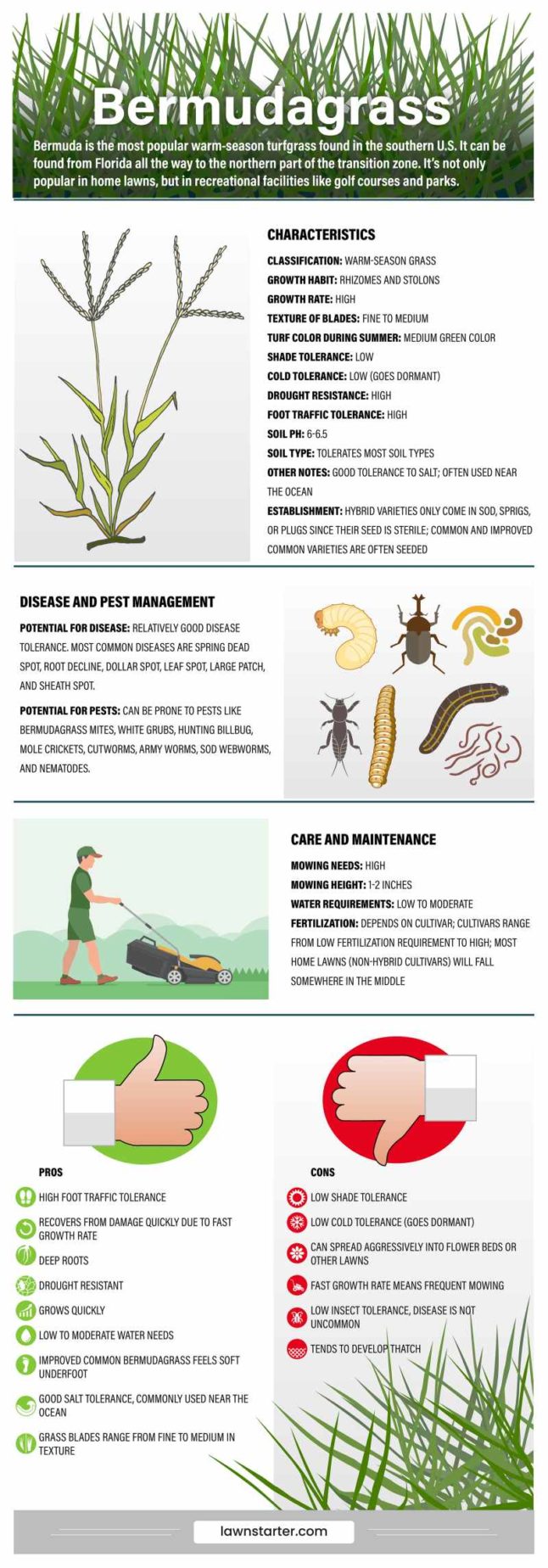
Characteristics of Bermudagrass
It’s a warm-season grass
As a warm-season grass, bermudagrass will turn brown and enter dormancy when cold winter arrives. In warmer temperatures, bermudagrass will green up and resume active growth. Consider overseeding in the fall with ryegrass to help maintain a year-round green color.
It has high wear tolerance
Bermudagrass is a terrific choice for active backyards where kids and pets play. In fact, that ability to withstand heavy traffic has made bermudagrass a popular choice for sports fields.
It has high drought tolerance
Bermudagrass tolerates prolonged dry spells. Drought will cause bermudagrass to enter dormancy and turn brown as it does in winter, but unlike grasses with low drought tolerance, bermudagrass has a higher capacity to survive.
Fun Fact: Bermudagrass has an even higher drought-tolerance than Zoysiagrass.
It has high salt tolerance
Bermudagrass has a high salt tolerance, which makes it a smart choice for coastal areas and inland regions that may occasionally get whipped with salt spray from hurricanes and tropical storms.
Why is salt tolerance important? Salt can affect your lawn’s health through saltwater intrusion, poor irrigation quality, or rock and mineral erosion. Grass with a high salt tolerance will better resist this exposure, particularly for lawns growing in coastal environments.
It has high heat tolerance
Bermudagrass can take the heat better than other warm season grasses. This also explains why bermudagrass is common in some of the hottest regions of the U.S.
Yes, warm-season grass can experience heat stress, despite preferring warmer temperatures, but bermudagrass can withstand extreme heat temperatures.
It has poor shade tolerance
You were hoping for another high tolerant trait, weren’t you? There is no such thing as a miracle grass (if there were, you can trust we’d tell you about it).
Bermudagrass has a low shade tolerance and should not be grown underneath tree canopies, building overhangs, or other shade sources.
It can be a weed
Bermudagrass spreads rapidly by stolons (above ground stems), rhizomes (underground stems), and seeds and has a deep-root system. Its rapid growth can make it difficult to control in flower beds and walkways. (See bermudagrass as a weed below.)
It’s high maintenance
If we haven’t said it enough already, bermudagrass will require management and proper care. If you can extend your maintenance regimen, bermudagrass will provide you with a high-quality lawn or sports field. If you prefer lower management requirements, consider using bermudagrass for areas in need of erosion control.
Regions Where Bermudagrass is Most Common
Bermudagrass is common in Australia, Africa, India, South America, and the Southern region of the United States, according to the Texas Cooperative Extension.
Bermudagrass was likely introduced to the United States from Africa or India.
The University of Arizona Cooperative Extension suggests that the introduction of bermudagrass occurred when slaves were tranported to America and bermudagrass was used for their bedding.
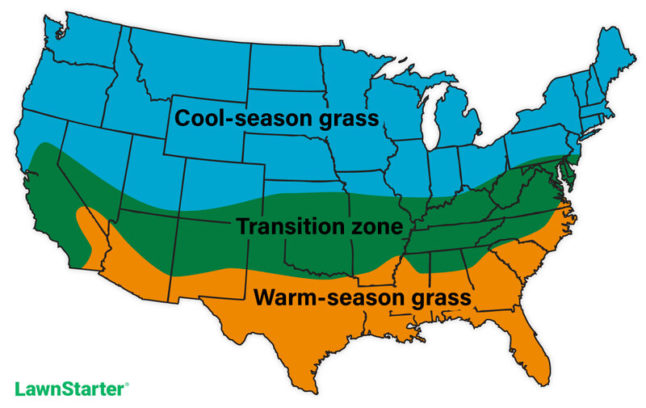
Bermudagrass can be found from New Jersey and Maryland southward to Florida and westward to Kansas and Texas, according to the Texas Cooperative Extension. This turf is a warm-season grass and prefers areas that have a warmer climate throughout the year.
Unlike cool-season grasses, bermudagrass won’t thrive well up north where temperatures are colder. Yet there are some bermudagrass cultivars in which the turf is bred to have more cold-tolerance, thereby extending its distribution to some northern areas.
Bermudagrass cultivars with a high cold-tolerance may also make a suitable turf for lawns in the transition zone. Homeowners in the transition zone often experience scorching summers and frigid winters that make it challenging to find a grass that thrives in either season.
That’s why transition homeowners typically opt for a cool- or warm-season cultivar that is resistant to cold or hot temperatures.
Care of Bermudagrass
Disease control
Bermudagrass is most susceptible to large patch, dollar spot, and spring dead spot, particularly during its growing season. Large patch and dollar spot are fungal diseases that typically occur during warm, wet weather.
To help reduce disease problems, ensure your bermudagrass has adequate soil drainage, thatch removal, and fertilizer. Avoid overwatering your lawn.
Mowing
The optimum mowing height for common bermudagrass is between 1 to 2 inches, while hybrid varieties frown best at 1/2 to 1.5 inches.
If your lawn is under environmental stress, such as drought or heat, raise the mowing height until the stress has passed. If you are growing a cultivar in partial shade, keep the mowing height to 2 inches.
For a higher quality bermudagrass lawn, mow your lawn frequently and keep it at a lower height. Make sure to avoid scalping, which will expose the turf’s stems if you mow too low.
Pro Tip: Mow your grass with sharpened mower blades. Dull mower blades may rip your grass rather than cut it, causing it to be more susceptible to disease.
Fertilization
Your fertilizing regime will be determined based on the results of a soil test. The Home & Garden Information Center at the Clemson Cooperative Extension recommends soil-testing bermudagrass in the spring through January and April.
Bermudagrass grows best at a soil pH of 6 to 6.5. If the pH is higher, consider applying sulfur to lower it.
The Clemson Cooperative Extension does not recommend fertilizing with nitrogen in early spring, as an unpredicted frost may damage your lawn after fertilization.
The NC State Extension suggests applying 1⁄2 to 1 pound of nitrogen per 1,000 square feet several weeks after the grass turns green, typically in early April or May.
If your bermudagrass lawn is yellowing, this may indicate an iron or manganese deficiency. Consider applying a chelated iron product or manganese sulfate as a remedy.
Aeration
Homeowners often blame a lack of fertilizer and water for poor lawn health before soil compaction. Soil compaction regularly contributes to lawn stress and blocks the flow of water and air.
For a high-quality, healthy lawn, aerate the soil in the summers when the grass is actively growing. Aerating your lawn can help loosen compaction and increase air, water, and nutrient flow.
Irrigation
Ensure your bermudagrass receives 1 inch of water each week. It’s time to water your lawn when your bermudagrass appears bluish-gray, wilted, or folded.
Water until the soil is wet to a depth of 4 to 6 inches. According to the NC State Extension, it may take 3 to 5 hours to apply 1 inch of water.
Thatch removal
Because bermudagrass is a fast-growing grass, it is susceptible to thatch buildup.
What is thatch? Thatch is the development of organic material between the turfgrass’s leaves and the soil surface. Thatch can make a cozy home for pathogens and pests, making your lawn susceptible to disease and insects.
Dethatch your lawn when the thatch layer is a 1/2 inch, the lawn has fully greened, and there is no threat of frost.
Weed control
Apply a pre-emergent herbicide early in the year (from late February to mid-March) to control weeds like crabgrass and goosegrass. Apply a second application 8 to 10 weeks after the initial application.
If a weed problem occurs as the grass begins to green, wait until the grass has fully greened before applying a post-emergent herbicide.
Insect control
Bermudagrass is susceptible to mole crickets and white grubs. Cold soil temperatures will typically keep insect problems under control, so there is little need to apply insecticides in winter.
An early spring rise in temperature may lead to mole cricket activity. Consider applying an insecticide treatment to control the pest.
Monitor your lawn for white grubs (the larvae of beetles) by cutting a square foot of sod. If you find more than six grubs under the sod, the Clemson Cooperative Extension recommends applying an insecticide.
Make sure any insecticide you use is labeled to treat the insect you wish to control. Follow all labeled instructions to ensure your safety and the best results.
Types of Bermudagrass
Common bermudagrass
Common bermudagrass (Cynodon dactylon) is the bermudagrass type traditionally established by seed. Varieties often have a coarse leaf texture and are a light green color.
Although common bermudagrass can provide a high turf quality, breeding efforts have achieved improvements in common bermudagrass to produce finer leaf texture, darker color, and improved density.
Improved common bermudagrass
Improved common bermudagrasses is a darker green, deeper-rooted, medium-fine textured, and moderately more dense than common bermudagrass. This bermudagrass type grows well in golf course roughs and fairways, parks, home lawns, and sports fields.
According to the Home & Garden Information Center at the Clemson Cooperative Extension, an ongoing problem for improved varieties of bermudagrass is the chance of reverting to their genetic parents and losing their enhanced characteristics.
Hybrid bermudagrass
Most popular bermudagrasses hybrids are a breed between common bermudagrass (C. dactylon) and African bermudagrass (C. transvaalensis).
Hybrid bermudagrasses are sterile, which means they must establish through plugging, sodding, or sprigging. These varieties are usually used in sports fields, golf courses, and highly maintained lawns.
Hybrid bermudagrass requires more care and attention than common or improved common bermudagrass lawns.
Although hybrid bermudagrass requires more management, it will typically produce higher quality lawns with fewer disease problems.
Bermudagrass as a Weed
Bermudagrass spreads by stolons, rhizomes, and seeds and can spread rapidly in unwanted places. Its growth makes it difficult to control, but the right management can help deter this grass from your flower beds, walking paths, and shrubs.
Withhold water
Though bermudagrass is highly drought-resistant, it still needs water to survive. Avoid watering any areas the bermudagrass has invaded as long as withholding water doesn’t affect other plants.
Increase shade
Bermudagrass has poor shade tolerance and will not grow well without full sun. Keep your bermudagrass in check by increasing shade with trees or tall shrubs.
Remove lawn clippings
Because bermudagrass can spread by seed, the seeds can spread by lawn clippings after mowing. Compost your lawn clippings to help reduce the spread of the grass.
Lay down mulch
Use black polyethylene as a mulch to help prevent sunlight from reaching the weed. Place the plastic over the grass for about 6 to 8 weeks in the summer. Make sure the plastic has no holes; otherwise, the grass will grow right through them.
Landscape fabrics, also known as geotextiles, are another effective mulch solution to kill bermudagrass. Ensure the material has no holes or gaps,
Wood chips are not as effective against bermudagrass, as the weed can easily protrude from this mulch.
Apply herbicides
Post-emergent herbicides can offer effective bermudagrass control in areas where the weed is actively growing.
Nonselective herbicides and grass-selective herbicides can both kill mature bermudagrass. Keep in mind that nonselective herbicides will kill most plant species, whereas grass-selective herbicides will only target plants in the grass family.
Is Bermudagrass Right for Your Lawn?
Considering what you need in a lawn may help you decide the best turf to pick. Do you need a wear-resistant grass that can handle backyard cookouts and volleyball tournaments, or do you need turfgrass that requires little maintenance?
Even a grass with plenty of valuable tolerances may not always be the best grass type for every lawn.
If your yard has lots of shade or you don’t have the resources for a high-budget grass, then a bermuda lawn may not be the best turf option. But if you’re looking for a high-quality lawn and can afford the maintenance, then bermudagrass can make an excellent turf.
When to Call a LawnStarter Pro
Consider calling a LawnStarter lawn care pro near you to mow, fertilize, and maintain your lawn. Hiring a professional lawn care provider lets you enjoy the benefits of a bermuda lawn without lifting a finger. If maintenance was the only concern holding you back from getting fresh turf, hiring help can be your ticket to a brand new, cushioned lawn.
Main Photo Credit: Bermudagrass / woodleywonderworks / Flickr / CC BY 2.0 with text overlay


